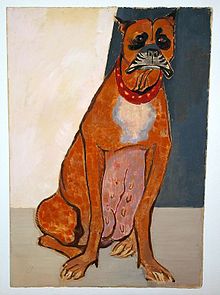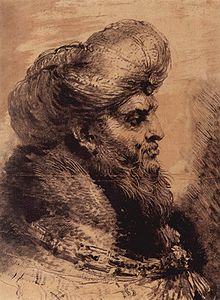- Monotyping
-
Monotyping is a type of printmaking made by drawing or painting on a smooth, non-absorbent surface. The surface, or matrix, was historically a copper etching plate, but in contemporary work it can vary from zinc or glass to acrylic glass. The image is then transferred onto a sheet of paper by pressing the two together, usually using a printing-press. Monotypes can also be created by inking an entire surface and then, using brushes or rags, removing ink to create a subtractive image, e.g. creating lights from a field of opaque colour. The inks used may be oil based or water based. With oil based inks, the paper may be dry, in which case the image has more contrast, or the paper may be damp, in which case the image has a 10 percent greater range of tones.
Monotyping produces a unique print, or monotype; most of the ink is removed during the initial pressing. Although subsequent reprintings are sometimes possible, they differ greatly from the first print and are generally considered inferior. A second print from the original plate is called a "ghost print" or "cognate". Stencils, watercolor, solvents, brushes, and other tools are often used to embellish a monotype print. Monotypes are often spontaneously executed and with no previous sketch.
Contents
History
The monotype process was invented by Giovanni Benedetto Castiglione (1609-64), an Italian painter and etcher who was also the first artist to produce brushed sketches intended as finished and final works of art (rather than as studies for another work). He is the only Italian to have invented a printmaking technique.[1] He began to make monotypes in the 1640s, normally working from black to white, and produced over twenty surviving ones, over half of which are set at night (Theseus finding the Arms of his Father, 1643).
William Blake developed a different technique, painting on millboard in egg tempera to produce both new works and coloured impressions of his prints and book illustrations. Few other artists used the technique until Degas, who made several, often working on them further after printing (Beside the Sea, 1876-7); Pissarro also made several. Paul Gaugin used a variant technique involving tracing, later taken up by Paul Klee. In the twentieth century the technique became more popular.
Comparing monotypes to monoprints
Monoprints and monotypes are very similar. Both involve the transfer of ink from a plate to the paper, canvas, or other surface that will ultimately hold the work of art. In the case of monotypes, the plate is a featureless plate. It contains no features that will impart any definition to successive prints. The most common feature would be the etched or engraved line on a metal plate. In the absence of any permanent features on the surface of the plate, all articulation of imagery is dependent on one unique inking, resulting in one unique print.
Monoprints, on the other hand, are the results of plates that have permanent features on them. Monoprints can be thought of as variations on a theme, with the theme resulting from some permanent features being found on the plate—lines, textures—that persist from print to print. Variations are confined to those resulting from how the plate is inked prior to each print. The variations are endless, but certain permanent features on the plate will tend to persist from one print to the next.
See also
- www.monoprints.com a website to learn the difference between monoprints and monotypes
- Monoprinting
- Paper marbling
References
- Reed, Sue Welsh & Wallace, Richard, Italian Etchers of the Renaissance and Baroque, Museum of Fine Arts, Boston 1989,pp 262–5,ISBN 0-87846-306-2 or 304-4 (pb)
- ^ Prints and Printmaking, Antony Griffiths, British Museum Press (in UK),2nd edn, 1996 ISBN 071412608X
External links
Categories:
Wikimedia Foundation. 2010.


